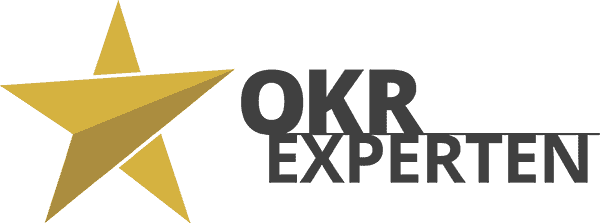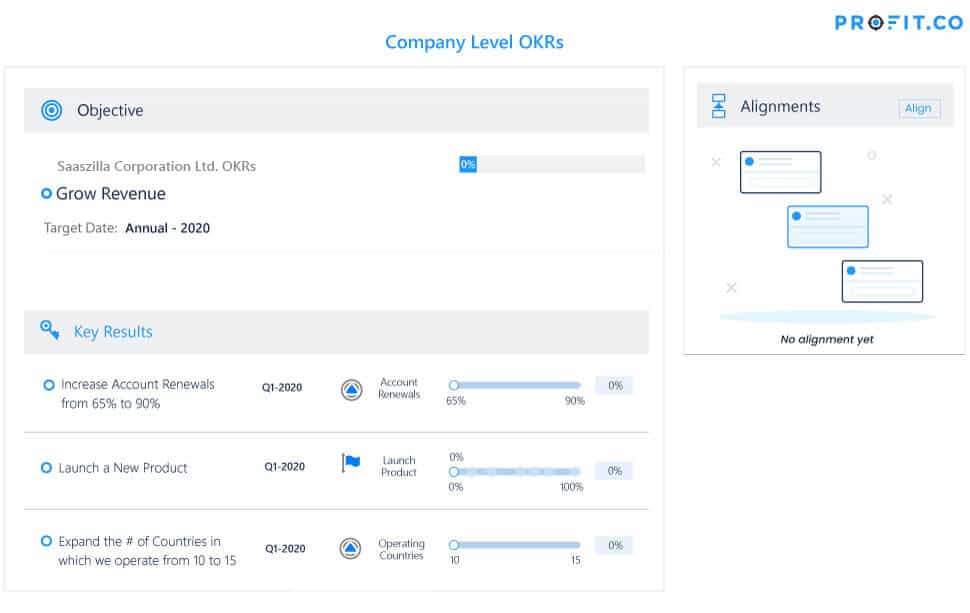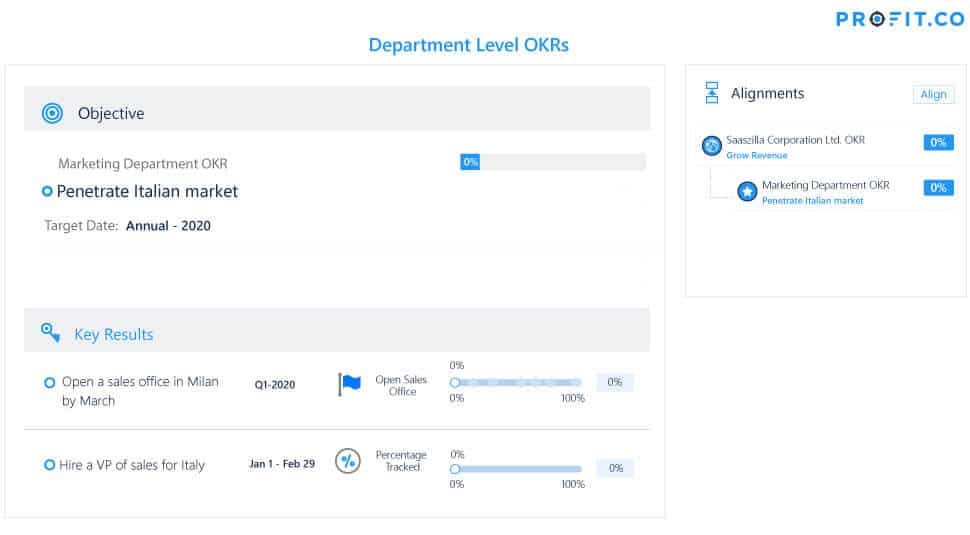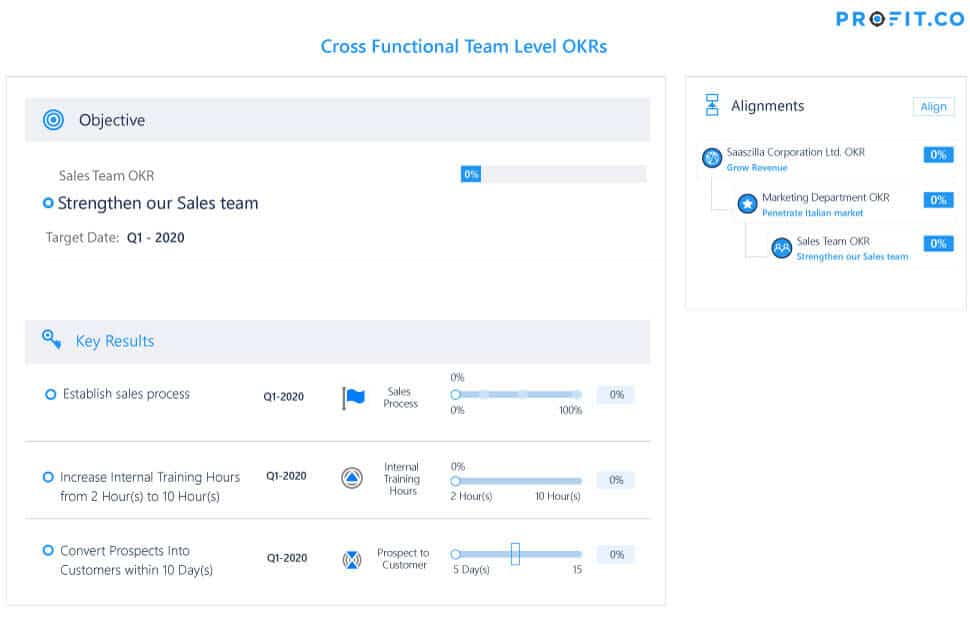
20 Apr Define different OKR levels
The different OKR levels
What are OKR levels?
We can define OKRs on four levels. Typically, there are several departments in every company. Sometimes there are also cross-functional teams that work on solving a specific problem. And of course there are employees who work in these different departments. So these are the 4 levels at which you define Objectives and Key Results, known as OKR levels.
They usually start at company level and set up company OKRs, which are usually valid for one year – sometimes longer. You should decide on three or four objectives and track their progress using 2 to 5 key results each.
OKRs at company level
Let’s assume that you have the objective and key result of increasing your sales at company level. Let’s call the goal “sales growth”. Fast forward one quarter or one year. How do you know that you have increased revenue? In the following, we would like to present some exemplary key results that will answer this question precisely.
The first key result could be: “Increase sales by 100%”. A second key result could be the launch of some new products. You can launch some new products in areas where your competitors are stronger than you. A third key result may be the development of some new geographical areas. You could also formulate the key result differently. For example: “Expand the number of countries in which we operate from 10 to 15 countries”. These are therefore corporate OKRs.
Every company should have identified 3-4 company OKRs, in our example one of them is “Increase in sales”. We have identified three key results for this. These key results from the companies’ OKRs are now assigned to the relevant departments. Sometimes a few departments share the OKR, sometimes responsibility lies with a single department.
OKRs at department level
Marketing and sales come into play at the next OKR level. Marketing has the task of creating new sales opportunities and opening up new markets. To enable growth, the sales team must nurture leads from marketing and then initiate the sales process. The research and development team must work on new products and improve existing products so that your products can hold their own on the market. The manufacturing and other service teams may need to either create additional capacity or introduce new production lines or production facilities to support growth targets.
Let’s take the marketing team as an example. One of the key outcomes at a corporate level is to increase the number of countries you operate in from 10 to 15, so the marketing team could determine that one of your goals is to “penetrate the Italian market”. This target is also measured against a number of key results. One of the key results could be the opening of a sales office. For example, if they decide to locate in Milan, it could read: “Open a sales office in Milan by the end of Q1 this year”. The second Rey result could be the recruitment of a vice-president for sales in Italy, based in Milan.
Once you have the site setup and a leader set, you can formulate a few Key Results to test the water a little. The 3rd key result for this quarter could therefore be to generate 30+ leads for Italy. And finally, a 4. key result is to have at least 3 reference customers from Italy. With this set-up, you could now proceed aggressively over the next three quarters. They would have a local office, a local manager. They would have demonstrated the ability to generate leads and finally have happy reference customers.
It is therefore a departmental OCR that is in line with the company OCR, “Increase in sales”. Specifically, it would tie in with the key result “Increase the number of countries in which we operate from 10 to 15”.
OKRs at cross-functional level
However, there are also situations where you think: “Okay, we actually need a team of people from different departments to execute this key result”. Interestingly, our “penetrating the Italian market” OCR may itself be a candidate for this. The opening of a sales office in Milan could in fact be the responsibility of the company’s real estate group, while the marketing department is merely the driving force. Of course, the business strategy department can also play a role. The hiring of the VP of Sales could be led by HR.
The OKR could therefore affect various departments. In this case, you could leave the responsibility with the team that is in the lead for the project, for example the marketing team. In this case, the other departments would only contribute to fulfillment. Or you could create a cross-functional team from all four departments and assign them a common objective and key result. This would make the responsibility clear to everyone.
OKRs at individual level
And at the last level, we see individual OKRs. Each employee can have their own OKRs. These are tasks that are derived from the other OKR levels, such as department or team level. Let’s take this example:
The department’s key result “Acquire 30 new leads for this quarter from the Italian region” could become a goal for the head of digital marketing. He might ask himself: “Okay, I need 30 new leads from the Italian market for this quarter, what do I need to do?” Okay, I need to place ads in certain places, let’s say Google ads or LinkedIn ads or newspaper or magazine ads. He might say, “I need to do some public relations, like announce that this company is entering this market, hold a press conference and do other things to get the word out,” which all leads to awareness.
So as awareness grows, people start to notice who you are and that you are there. If you then have an appealing, interesting website, you will attract more visitors and increase interest in your company. This is how you can go from zero to 30 leads. Of course, you don’t need to have followed OKR to get this result. You could have simply worked through a list of tasks. However, only the OKR method makes it possible to break down company OKRs to individual OKRs and thus never lose sight of the company’s vision.
Defining OKR levels – What is the best approach?
This question receives the most universal answer in the management sector – it depends. Obviously, the maturity level of the OKRs in your organization will be a big factor in deciding at which OKR level you want to start. If you have just started to introduce OKRs, the existence of several levels of OKRs can quickly lead to an overly complex environment and cause confusion: At which level do I define this OKR? Why is this OKR at the individual level and not at the department level? Etc.
It is therefore better to limit yourself to perhaps two levels at first and continue from there. For example, you could start with company-wide and departmental OCRs. Let the program run for a few quarters and then slowly introduce team OCRs, e.g. when a cross-functional project is due. And once again, do this for about two, three, four quarters. So everyone slowly starts to get used to OKRs. So everyone will understand what OKRs are, how to set objectives, how to achieve good key results, how to review them and how to track progress.
And more importantly, often when you start with individual OKRs, there is a certain amount of fear that you are measuring their performance using a system. The employees think: “Oh, so that’s what I’m being judged on. I write my goals in such a way that I will definitely achieve them.”
If you now start with company OKRs or company-wide OKRs and departmental OKRs and then slowly move on to team OKRs and then individual OKRs, this fear factor should diminish greatly through experience and presence. If you encourage your employees to create their own individual OKRs, they will live up to the OKR philosophy. They create goals and key results that in some cases are ambitious and committed, in other cases perhaps less so.
Summary
So you could experiment with the OKR levels in your organization. You can find more articles on the subject of OKRs and their application in our expert magazine.








